Parallel String Batteries In High Voltage Applications.
This article discusses the use of parallel string batteries in high voltage applications but the contents may be considered for any battery voltage.
The subjects discussed in the paper are: -
A) What do we mean by Parallel String Batteries?
B) What do we mean by High Voltage Batteries?
C) History of Parallel String Batteries and Past Problems.
D) How many Parallel Strings in One System?
E) Inter String and Main Cables.
F) Circulating Currents on Charge & Discharge.
G) Differential Currents on Discharge & Recharge.
H) Battery Reliability.
I) Paralleling Batteries of Different Capacities and from Different Manufacturers.
J) Advantages of using Parallel String Batteries.
A) What do we mean by Parallel String Batteries?##
In a parallel string battery arrangement one string is connected in parallel with another string. It may consist on one additional string or many additional strings. It is not uncommon for a high voltage system supporting a UPS system for 6 strings to be in parallel. Some 48V systems have 50 strings in parallel and in rare cases, even more.
When cells or monoblocs are connected in series the voltage of the system is increased. For example, 2 lead-acid cells of 50Ah each connected in series would be a battery having a nominal voltage of 4V and a capacity of 50Ah.
Fig 1 below shows a simple 2 string arrangement.
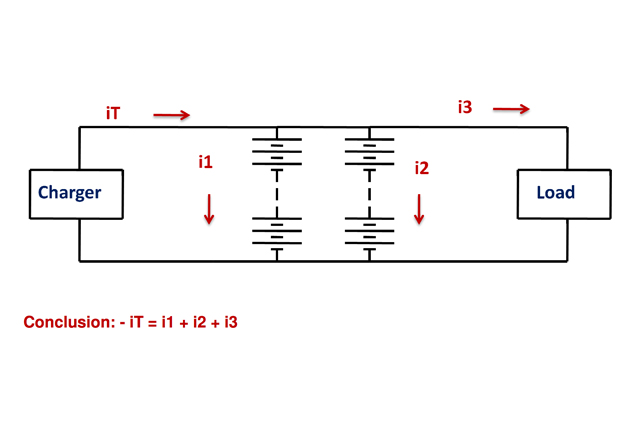
B) What do we mean by High Voltage Batteries?##
National and International standards define High Voltage Batteries as any battery where 60 or more cells are connected in series; i.e. greater than 120V nominal
In this paper we consider a parallel battery to be more than one string of cells or monoblocs connected to the same charging source and load over 120V. However, much of the content of this paper may be applied to any battery voltage.
C) History of Parallel String Batteries & Poor Design Problems.##
Until VRLA batteries became popular the design philosophy was to use large vented cells and if the required Ah capacity exceeded about 2000Ah, another string was added.
When VRLA AGM product first found its way into the market place, only a few types were available in 2V spiral wound format up to about 25Ah. This capacity was not practical for many applications. In the early 1980’s prismatic types were introduced from 2 or 3 manufacturers from about 6V 50Ah up to 2V 450Ah. However, only about 6 capacity / voltages were available. If demand required a larger Ah capacity then parallel strings were used. Initially this was for 48V Telecom Applications but demand soon required larger capacities for UPS applications.
Design Engineers were concerned about the distribution of cell voltages over a large number of cells connected in series and many UPS batteries required typically in the order of 180 cells. In any string, the current will be the same in all cells providing no inter connections are made. However, with 2 or more strings the current flow and voltage equalisation was a concern because each string may have a different charging and discharging current. It had been shown that for 48V batteries, the current sharing was not a problem. Some early high voltage parallel string batteries had “equalising” connections typically every 20 cells. This proved to be a serious error. See Fig 2, Fig 3, Fig 4 and Fig 5 below illustrate what can go wrong with equalising connections.
Fig 2: Shows Equalising Connectors.
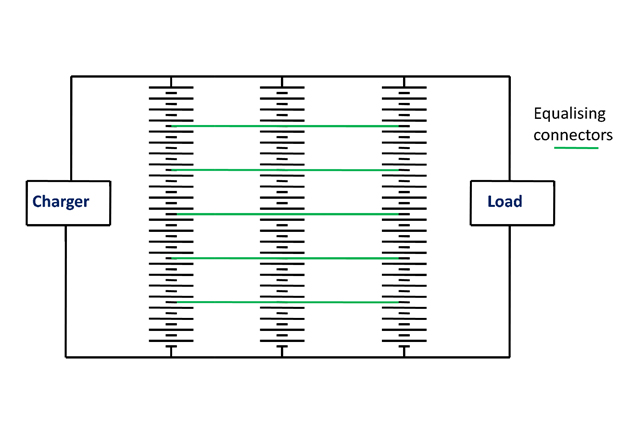
Fig 3: Illustrates what can go wrong when equalising connections are made.
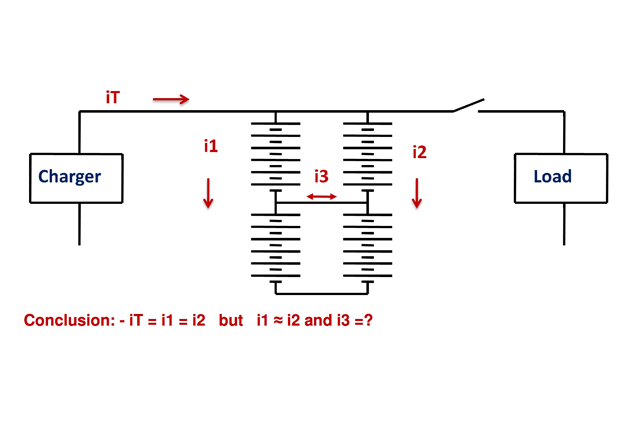
Fig 4 below shows what can happen if a cell goes to open circuit or if an inter connector develops a high resistance which may be due to poor instalation or corrosion etc.
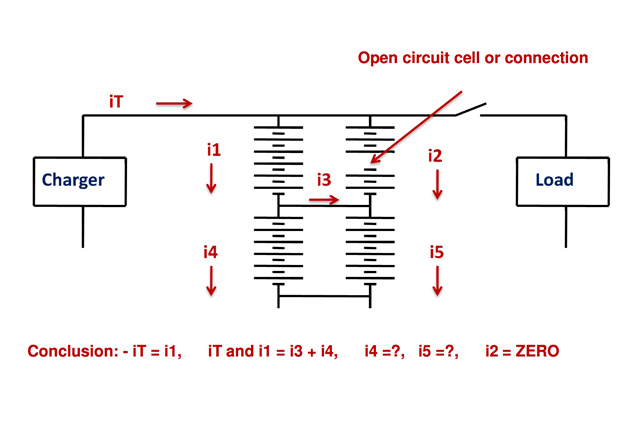
Fig 5: Illustrates the effect of a short circuit cell.
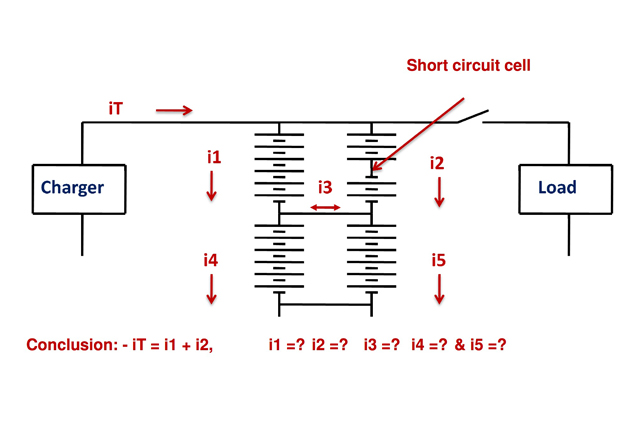
With a large difference in the ohmic value of the two strings the complete battery system would eventually fail because the strings would not have the required charging current.
Equalising connections as shown in Fig 2 above should not be fitted. The only paralleling connections should be fitted to the end of string terminals.
It is fair to say that the industry has learned from its mistakes and equalising connections are no longer fitted.
D) How many Parallel Strings in One System?##
How many would you like?
The first published Standard stated 4 as a maximum. Why 4? This was the maximum of experience and the industry was cautious following the problems encountered with equalising connections. Today the industry has much more experience and we know that 10 string high voltage batteries are operating without problems.
E) Inter String and Main Cables.##
It is recommended that “daisy chains” are avoided, see Fig 6 below. Note that cable lengths from the charger and to the load are different for each string.
Cable CSA should also be the same from charger to strings and from strings to load.
Fig 6: Avoid “daisy chains”.
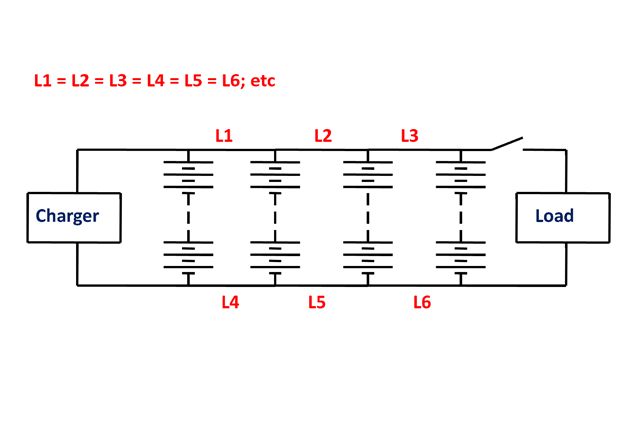
Although it is desirable to keep the cable lengths and CSA the same, it has been shown that this is not essential. When the discharge current or recharge currents are high, different voltage drops may occur. On discharge this is not a problem but on charge it is argued that this may result in different string charging voltages which may lead to string “balancing” problems. It is further argues that this is not an issue because as the battery becomes more and more charged, the current reduces and the voltage drop also reduces and the string voltages will stabilise within acceptable limits. Ultimately, the string voltages will equalise and the system will automatically “balance”. Fig 7 below illustrates the “desirable” but not essential situation.
Fig 7: Preferred cabling.
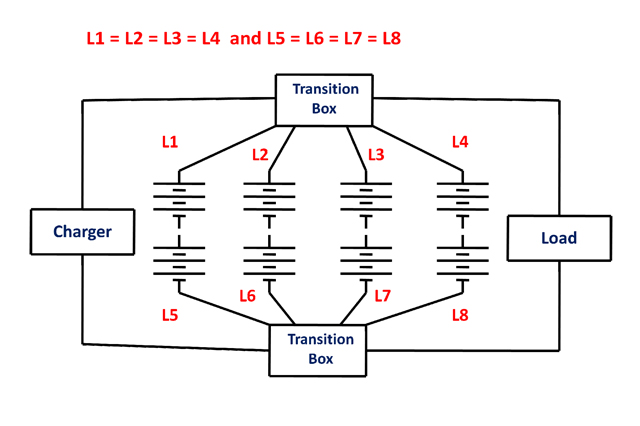
F) Circulating Currents on Charge & Discharge.##
What happens if we have one string discharged and one charged and what will be the value of the current flowing between the strings?
This scenario will occur if one sting has been test discharged and is then reconnected to the other string or strings.
A problem encountered on several occasions has been seen during capacity testing of batteries having parallel strings where each string was tested individually. When one sting (A) was tested it passed the test and then reconnected to other strings but this was before being fully recharged. The second string (B) was then tested and failed. Then string B was reconnected before being fully charged. The third string (C) was tested and this failed.
Evaluation of the test results of this real case showed that in string A no cells failed the test; 3 cells in string B failed; 8 cells in string C failed and all 24 cells in string D failed. It was concluded that because the individual strings were not fully charged prior to being reconnected to the other strings, they progressively drew current from the others which reduced their state of charge. As the tests continued, the situation became more acute to the point that all 24 cells in string D failed the test.
Fig 8: With string A fully charged and string B fully discharged, switch 2 is closed. In a real test the resultant circulating current was 10 x C10 amperes for 0.2 seconds reducing exponentially to 0.2 x C10 amperes after 3h.
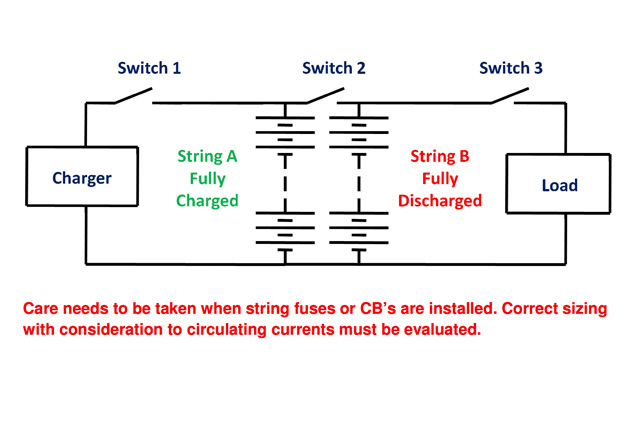
G) Differential Currents on Discharge & Recharge.##
Most battery manufacturers would consider a discharge current differential of 10% from string to string to be within acceptable limits However, in real terms any differential of more than 5% should be investigated. On charge, the differentials are less noticeable because of the low currents flowing in the strings but the same 10% differential limits should be considered.
H) Battery Reliability.##
It has been argued that having more than one string will increase the total reliability. Caution has to be made because in a two string configuration, if one string is lost the remaining string may not provide power for even a few seconds. On the other hand, if a single string battery fails the outcome is the same. Even in a 3 string system, for short standby times such as 5 minutes, if one string is lost the remaining 2 strings may not provide any power. In some extreme cases even when using 4 strings, the loss of one string may still result in no available standby time.
I) Paralleling Batteries of Different Capacities and from Different Manufacturers.##
There should be no issues with paralleling batteries of different capacities providing the same numbers of cells are in each string. For example a 330 cell string of 175Ah may be paralleled with a 330 cell string of 25Ah giving a total battery system of 330 cells of 200Ah. Some manufacturers may disagree with this practice but in reality, providing the correct float voltage is presented to each string the system will work without problems. On charge, circulating currents are avoided because each string will have the same float voltage applied. On discharge, each string will deliver power to the load in proportion to the capacity. Some small differences may be found because of variations in the internal ohmic value of each string due to connections and connector type.
In a system with strings from different manufacturers, providing each battery type requires the same nominal float voltage, no issues are likely to be experienced. Again, battery manufacturers will discourage this practice but there are many systems, particularly of 48V where it is common practice to parallel different manufacturer’s product. In most cases, the product is not of the same age and not of the same Ah capacity. These systems have been running for many years without problems.
J) Advantages of using Parallel String Batteries.##
Advantages include: -
• Better cell or monobloc efficiency which reduces the overall battery cost.
• Better Ah battery efficiency reduces the total battery capacity required which reduces the overall battery cost.
• Easier manual handling at the manufacturing stage which reduces manufacturing costs.
• Easier to handle on site which reduces installation costs.
• Possibility of using monoblocs instead of individual cells which generally reduces cost due to the above reasons.
• Parallel string batteries are generally smaller in physical size which reduces the battery room requirements.
Disadvantages include: -
• More individual units which can, in some instances increases the installation costs due to more inter unit connections having to be made.
• More individual units will increase the maintenance time in checking voltages etc.
This concludes our latest technical blog post, make sure you continue to follow our blog posts for ongoing information and support on a range of battery related subjects and common issues experienced in the field, wether it be for large industrial battery systems or simple maintenance advice for smaller battery applications. We at Blue Box Batteries are available to assist on a wide range of requirements whatever they may be.
Latest Headlines
Bulk Orders
Discounted prices are available for bulk orders, please contact us to discuss your requirement.